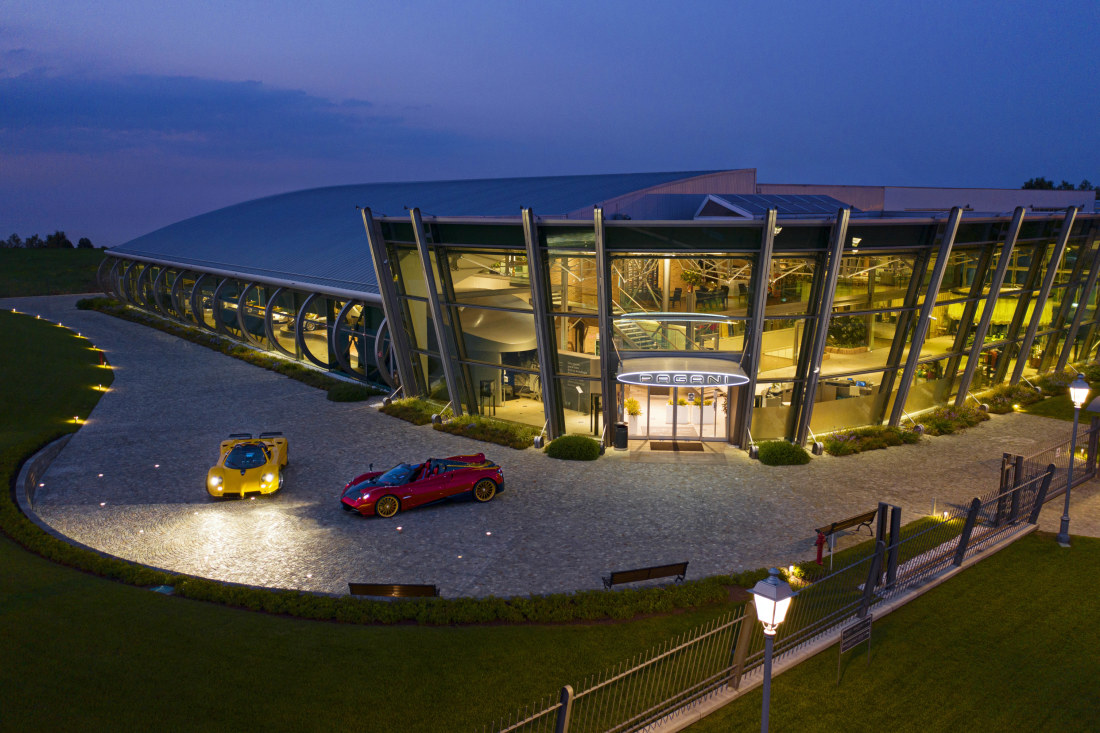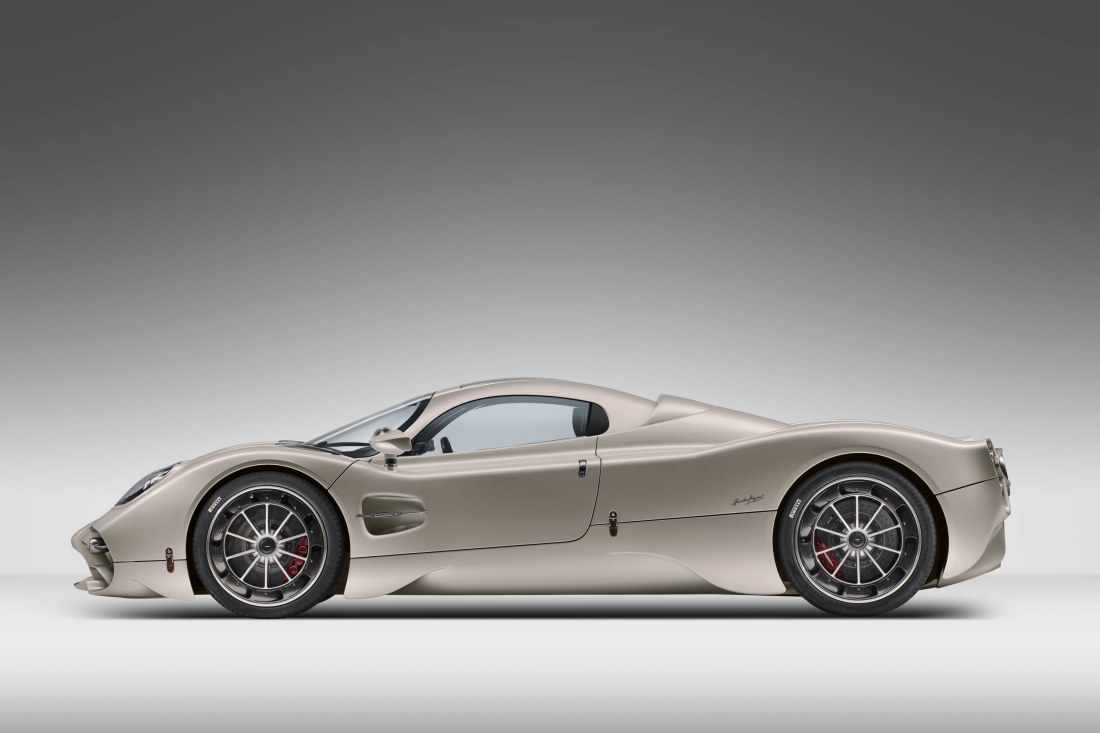- Driving with Tony Davis
- Life & Luxury
- Cars, Bikes, Boats
Behind the scenes at Pagani, where hypercars cost up to $23m
The Italian maker’s next car, the Utopia coupe, is priced in Australia “from about $6.5 million”. But nobody ever orders a standard version.
I’m only three kilometres away from Pagani Automobili, according to the satnav. But it’s all just empty fields and crumbling stone walls. The verges of the narrow Italian roads are edged with waist-high weeds.
We are south-east of Modena, in Emilia-Romagna’s so-called Supercar Valley (home to Ferrari, Lamborghini, Maserati, Ducati and more). But these surrounds are not where you’d expect some of the world’s most expensive cars to be made.

The Pagani factory’s elegant facade. A tour will set you back a mere $90.
Soon I can see a small clump of slab-sided factories in the distance. They are as colourless as the surrounding terrain. And yet, once among them, it’s clear I’ve found what I’m looking for. In the centre is a building with an elegant, curved glass façade and an exoskeleton inspired by the metal beams of the Eiffel Tower.
The stylised letters above the cobblestone forecourt spell out Pagani, the name of the man who designed the building, and the cars being produced inside it.

The latest Pagani is the Utopia coupe, and it will set you back at least $4.27 million.
Horacio Pagani, now 68, came to Italy from Argentina in 1983 with one aim: to make supercars. It wasn’t until 1999 that the first Pagani car, the carbon-fibre-bodied Zonda, was shown to the world. Since then, the company has thrived while countless similar projects have failed. Clearly something is working; after all, Pagani is not a vanity offshoot of a bigger corporation. It has to stand on its own feet.
The building houses the production facilities and a museum with several Pagani prototypes, plus Horacio’s earlier projects on two and four wheels, memorabilia and even juvenilia (including wooden “dream cars” he made as a child). There is a shop selling everything from T-shirts through to impossibly expensive Pagani-designed glass-plate cameras, and a carousel onto which each new Pagani “hypercar” (the term now used for the most extreme supercars) is placed for an elaborate hand-over ceremony. The adjacent grand piano provides the soundtrack.

The company’s latest models on the factory floor.
Currently, the carousel carries the most expensive Pagani ever: the HP Barchetta from 2017. This one is supposedly Horacio’s own, a further two were made and sold for something above $23 million apiece, plus taxes and freight.
For somewhat less – about $90 in fact – punters can book a tour of the museum and production facilities. There are four tours every day, with up to 30 people in each, proving that interest is high for a company that today produces just 50 cars a year, and is well off the beaten track.
The factory is as impressive as everything else, perhaps even more so. It’s modelled on an Italian town square, with Carrara marble highlights and Renaissance-style brick arches marking out a series of “ateliers”. In these, certain work is done to each car as it moves around the facilities. There are no conveyor belts or robots, just a clock tower that rings each hour. There is also an incongruous Mickey Mouse statue. Horatio is said to be a fan.

Inside the factory, artisans and engineers put the finishing touches to production models of the Utopia.
On the first floor are the carbon-fibre production facilities; an expertise in the exotic, lightweight material is the foundation of the company. Pagani produces at least 40 different types of carbon-fibre, each tailored to the specific requirements of different parts of the car. The most extreme type has titanium thread woven through it. The panels are baked on moulds in the massive kilns on the premises.
Right now, Pagani is working through the 99 promised units of the latest model series, the Utopia coupe. Before this was the Huayra, which replaced the original Zonda.
When we tour, there are 10 Utopias in various stages of production (a convertible is likely to follow the 99 coupes). Although the standard version of the Utopia officially costs €2.6 million ($4.27 million), ex-factory, I’m told nobody has ever ordered a standard version. Everything can be, and is, tailored to the buyer.

The Utopia is not lacking in firepower: there’s a beautiful twin-turbo V12 in there.
The cars are described by the company as “masterpieces” and, looking at them in various stages of production, it’s hard to disagree. No matter what you think of such outrageously priced and impractical objects, or even whether you like the design, the detail work in every area is simply exquisite. There’s almost no individual part that couldn’t be put on display on its own. Even things normally hidden from view, such as the parts of the floor underneath the seats are made to look beautiful. Just because.
The intricate linkages for the standard manual and sequential transmissions (you can have either with Utopia) are milled from solid billets of aluminium and left uncovered. The speedometer and rev counter reveal their clockwork through the glass. The car’s open tail allows you to see the moving driveshafts when following it.
The factory tour also hides nothing, except future products (research and development is conducted in a more private facility a few streets away), and the restaurant-quality staff canteen.
A Pagani car has 3000 components, I’m told. Much of it is made and assembled by hand in the tradition of the Italian sports cars of the 1950s and 1960s, but with the latest tech (the company motto is “Art and Science”). A Pagani takes four to eight months to assemble, depending on the configuration. When the company completes its run of Utopia coupes mid-next year, it will have produced just 550 vehicles in 26 years.
The engine – a twin-turbo V12 – is also handmade, but it is trucked in from AMG in Germany. The Mercedes division builds it to a unique specification and it’s badged Pagani. Power and torque is massive – up to 635 kW and 1100 Nm – for a car that weighs less than a VW Golf.

The care and prevision with which each masterpiece is built accounts for the limited number of cars that roll off the production line each year – and the price tag.
As well as the regular production cars, the company makes “one-offs” and “few-offs” via its delightfully named Grandi Complicazioni department. Based on existing models but with unique styling and features, these specials have included the Zonda-based HP Barchetta mentioned above and the Codalunga. This is a completely rebodied, long-tailed version of the Huayra coupe.
Lorenzo Kerkoc, who has been with the company since 2013, is the man in charge of Grandi Complicazioni, and he tells us the term comes from the watch industry, as its techniques are a major influence.
“We can develop new bodywork,” he says, “we can develop new aerodynamic packages, we can develop new mechanical components, like an extremely lightweight exhaust in titanium, so we can do whatever the customer wants.”

Details, details: even standard Utopia models are exquisite but if you have the means, bespoke is the way to go.
Kerkoc says a “one-off” would generally start at €5 million, and could be certified for use anywhere in the world. Pagani produces its machines in left- and right-hand drive, which is why they are available in Australia, and Mercedes ensures emissions compliance even for the toughest regions.
One of the stranger sights within the factory is the presence of older cars being worked on. Pagani, perhaps uniquely, will take back your second-hand model and modernise it, adding the latest powertrain or electronics, or a new wing, or close to anything else you require (and are prepared to pay for).
Meanwhile, the Utopia is priced in Australia “from about $6.5 million”. See zag.com.au/brand/pagani
Coming soon
- Driving the $11 million-plus Pagani Huayra Codalunga coupe.
Subscribe to gift this article
Gift 5 articles to anyone you choose each month when you subscribe.
Subscribe nowAlready a subscriber?
Introducing your Newsfeed
Follow the topics, people and companies that matter to you.
Find out moreRead More

Latest In Cars, bikes, boats
Fetching latest articles